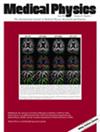Impact of nuclear fragmentation and irradiation scenarios on the dose-averaged LET, the RBE, and their relationship for H, He, C, O, and Ne ions
Abstract
Background
Projectile and target fragmentation are nuclear phenomena that can influence the computation of the linear energy transfer (LET) and the relative biological effectiveness (RBE) in external radiotherapy with accelerated ions. Correlations between these two quantities are routinely established during radiobiological experiments to interpret the results and to develop and calibrate RBE models.
Purpose
This study systematically evaluates the impact of secondary fragments and irradiation scenarios on the dose-averaged LET, the RBE, and their correlation in the case of exposures to clinically relevant ion beams.
Methods
57 600 microdosimetric lineal energy spectra and corresponding LET distributions were simulated with the Monte Carlo code PHITS across different scenarios, including track segment calculations, pristine, and spread-out Bragg peaks of 1H, 4He, 12C, 16O, and 20Ne ions within water phantoms. The LET distributions were analyzed to calculate the dose-average LET, both including or excluding the contribution of secondary ions of an element different from the primary beam. Similarly, the lineal energy distributions were processed in conjunction with the Mayo Clinic Florida microdosimetric kinetic model to compute the RBE for two theoretical cell lines (α/β = 2 and 10 Gy in the case of 6 MV x-rays). Correlations between the RBE and dose-averaged LET were established by analyzing the simulation results within water phantoms and then compared to the corresponding trends from the track segment calculations.
Results
Excluding secondary fragments had a pronounced impact on the dose-averaged LET and the RBE, particularly in the entrance regions of proton beams and close to the distal edge of heavier ions. The correlations between the RBE and the dose-averaged LET were not universal, but highly dependent on the irradiation scenario. For proton beams only, the dose-averaged LET of hydrogen ions served as a practical first-order descriptor of the RBE. Track segment simulations, commonly used for calibrating and benchmarking RBE models, provided a reasonable approximation for low-energy beams but failed to fully capture the complexity of polyenergetic radiation fields.
Conclusions
Secondary fragments can substantially affect the dose-averaged LET and the RBE, even in proton beams. The dose-averaged LET, including or not the contributions from secondary fragments, was generally unable to adequately capture RBE variations across different scenarios. A more comprehensive approach, considering microdosimetric distributions, is necessary to accurately describe RBE variations in ion therapy.

 求助内容:
求助内容: 应助结果提醒方式:
应助结果提醒方式:


